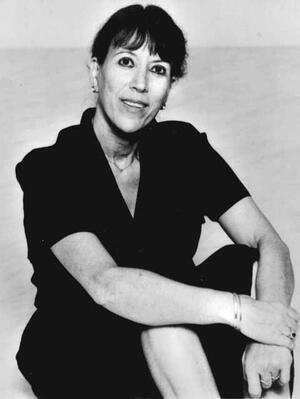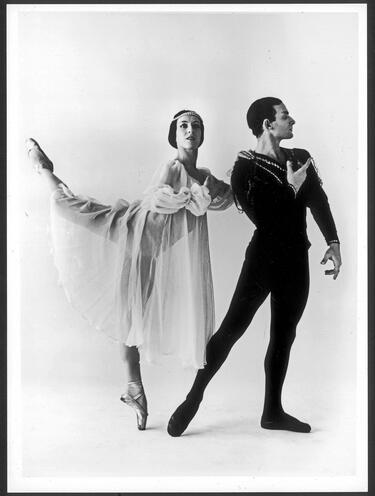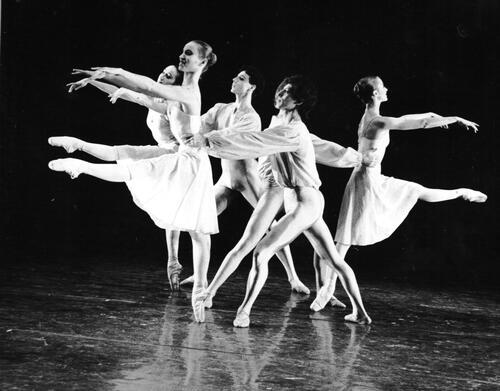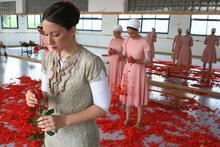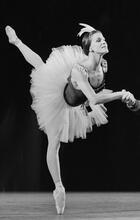Berta Yampolsky
Dancer and choreographer Berta Yampolsky founded the Israel Ballet in 1967 together with her husband Hillel Markman. Both Hillel and Berta had appeared as soloists with many companies worldwide, including in Belgium, Switzerland, France, and with the Ballet Russe de Monte Carlo in the United States. In 1964 they returned to Israel, where they were appointed the main dancers of the ballet company in the Israeli Opera established by Edis de Philippe. Yampolsky was the artistic director and the Israel Ballet choreographer. Her repertoire included dramatic and abstract dances in neo-classic ballet style. Under Yampolsky’s artistic direction, the company has performed works by George Balanchine, Rudy van Danzig, Krzysztof Pastor, Viencenta Nebreda, John Cranko and others. Yampolsky and Markman directed the company for five decades.
Berta Yampolsky and her husband Hillel Markman founded the Israel Ballet in 1967, serving as artistic directors until their resignation in 2012. Berta was the choreographer of most of the company’s repertoire and Hillel the general manager. The Israel Ballet’s repertoire includes some of the most famous classical ballets as well as contemporary ballets in the neo-classic style.
Early Life & Family
Yampolsky was born in Paris to Zionist parents. Her father, Naftali Yampolsky (c. 1893–c. 1980), was born in southern Russia. Drafted into the Russian army, he deserted and managed to reach France, where he studied engineering. Her mother Yokheved (Vera), née Shenker (c. 1900–c. 1980), was born in Odessa, the daughter of a fruit and nut merchant. She began studying medicine in Geneva and completed her studies at the University of Paris, where she met Naftali.
When Berta was three years old, she emigrated to Palestine with her parents and her older sister Sarah, and the family resided in Haifa. Yampolsky studied at a religious girls’ school in Haifa, then at the Hugim school and the Relai School. At the age of fourteen she began to study dance with Valentina Archipova Grossman.
In 1956 Berta met Hillel Markman, who enrolled as a dance pupil of Grossman. They married in 1957 and went to England to continue their dance studies. While Hillel studied with Ballet Rambert School, Yampolsky attended the Royal Academy of Dance and later Sadler’s Wells Ballet School. Both Hillel and Berta appeared as soloists with many companies worldwide, including in Belgium, Switzerland, France, and with the Ballet Russe de Monte Carlo in the United States. In 1964 they returned to Israel, where they were appointed the main dancers of the Israeli Opera’s ballet company established by Edis de Philippe. A year later they left the opera company, realizing that they would not be able to make their dream of starting a high-level ballet company come true in that setting.
The Israel Ballet Company
When Berta and Hillel left the Opera, Ruth Ziv, Rivka Rodiako, Leah Dvai, and Dalia Kusht went with them. The couple looked for a place outside Tel Aviv and founded the Holon Classical Ballet Ensemble in 1967. Because they did not have money to invite choreographers, the first program featured classical numbers they often performed abroad, such as Pas de Quatre (m. Pugni), the Anton Dolin/Kate Lester version, the Serge Lifar duet from Romeo and Juliet (m. Tchaikovsky), and Marius Petipa’s choreography from Don Quixote. They were supposed to have performed in other cities but were prevented by the security situation, just prior to the outbreak of the Six Day War. The only show they did not cancel was the one at Bet Hahayl in Tel Aviv. The hall was half full, with only women, because the men had already been called up.
The Holon municipality did not provide the hoped-for support, so in 1970 the dancers moved to Tel Aviv. Using money obtained from her father, Berta changed the name to the Classical Ballet and opened a ballet school linked to the ensemble. At the time there were no high-level locally born ballet dancers in Israel and the solution – made possible by the Jewish Agency – was to import Jewish dancers from the United States and Canada, the best-known of whom were soloists Pamela Osserman and Marcia Zussman.
As a significant development occurred in 1975, when the company – now called the Israel Ballet – was invited to perform at the Israel Festival and George Balanchine granted it performance rights to his Serenade and the pas de deux from Agon free of charge. Other important works in the same program were Electrobach by Felix Balska and Sweet Agony by African-American Gene Hill-Sagan who chose to live in Israel and choreographed several works for the company. The Israel Ballet took the audience by surprise and the critics praised it enthusiastically. Some even contended that a miracle had taken place in that a classical ballet company had come into existence in Israel that had a history hostile to ballet.
In 1977 the Israel Ballet Company, which now numbered twenty-five dancers, was invited to tour the United States. In 1981 it was invited for a nine-week tour of the United States and South America. In Santiago, Chile, Yampolsky won the prize for best foreign choreographer for her Dvorak Variations (1981).
The Israel Ballet dances Bertha Yampolsky’s “Harmonium” (1988)
The Israel Ballet has performed works by George Balanchine, Rudy van Danzig, Krzysztof Pastor, Viencenta Nebreda, John Cranko, Marius Petipa, Michele Fokine, and others. Yampolsky continued to develop as a choreographer and from the mid-1980s on she gradually became the sole Israeli choreographer for the company. Her repertoire of 27 works includes mainstream highly professional dramatic and abstract ballets. Her works excel in aesthetics and clear compositions in the neo classical style. From her repertoire stand out works such as Cinderella (1986), Dancing to Songs by Israeli composers Sasha Argov and Mati Caspi (1986), Two by Two (1989), Harmonium (1989), a full-stage production of Romeo and Juliet (1989), Valse Mephisto (1992), Gurre Lieder (1996), Ecstasy (1998), Medea (1999), Optimus (2003), Written in the Sand (2005), and Ko Beneti (2012).
The Israel Ballet dances Bertha Yampolsky’s “Mendelssohn Concerto”
The leading soloists in the Israel Ballet were Wendy Lucking from England, who married an Israeli and settled in Israel, Naama Yadlin, and Orna Kugel, born and educated in Israel. The second wave of Jewish immigration from the Soviet Union in the early 1990s brought many high-level professional dancers to Israel; many of them joined the Israeli Ballet, including soloist Nina Gershman.
Achievements &Allegations
The Israel Ballet dances Bertha Yampolsky’s “Romeo and Juliet”
Towards the end of the 1990s, increasing dissatisfaction with the Yampolsky repertoire began to arise, along with the belief that the company needed a more interesting choreographer. The higher the company’s standards grew, the more it became worthy of a choreographer with a new perception that could lead it forward. There were also serious allegations against Yampolsky and Markman, who totally controlled the company, as well as criticism that Yampolsky was the sole Israeli choreographer, that other Israeli choreographers were not invited to create for the company, and that the company did not nurture creators among its dancers.
Critics argued that providing opportunities and fostering local talent were part of the leading Israeli classical ballet company’s obligations. Discussions with management on the need for change fell on deaf ears and were seen as schemes to drive Yampolsky and Markman out. Their unwillingness to change stood out in contrast to an atmosphere encouraging of creativity that developed in the 1990s. A decade later, that atmosphere had spawned generations of Israeli contemporary choreographers, but not classical ballet choreographers.
In 2012, Yampolsky and Markman appointed Leah Lavie as General Manager of the Israel Ballet and Hillel became Honorary President. At the same time, talk of the need for a change in the Israel Ballet increased, as well as the need to develop replacements for the couple. The same year, Itzik Galili decided to return to Israel after years in Holland. Recognized as a talented choreographer who had created dozens of works for a long line of important companies, he was regarded as a good choice and was invited to raise a work for the Israel Ballet. He conquered local audience with Hikarizatto, a dynamic, very technical ballet that entered Israel Ballet into the 21st century.
Later that year, Lavie, backed by the Executive Committee, fired Yampolsky and Markman. They were deeply hurt and sued the Israel Ballet, especially blaming Lavie. Lavie has become a strong figure in the Israel Ballet. Surprisingly, Galili was not elected Artistic Director but rather Ido Tadmor, whom Lavie preferred. A year later Tadmore left; since then artistic directors have changed frequently. In 1998, Berta Yampolsky won national recognition as the recipient of the Ministry of Education and Culture’s Lifetime Achievement in Dance Award. In 2019, she published her book Optimists about her lifetime project of the Israel Ballet, ending with the complicated relationship with the company.
Anawalt, Sasha. “Israel Ballet Performs Exquisitely.” Los Angeles Herald, April 16, 1984.
Eshel, Ruth. Dancing with the Dream: The Beginning of Artistic Dance in Israel, 1920–1964. Tel Aviv: Sifriyat Hapoalim and the Dance Library of Israel, 1991.
Eshel, Ruth. “Classical Ballet: Israeli Dance’s Stepchild” (Hebrew and English). Mahol Akhshav (Dance Today) 2 (July 2000): 85–93. Available at https://www.israeldance-diaries.co.il/en/magazines/dance-today/.
Eshel, Ruth. Dance Spreads its Wings: Israeli Concert Dance 1920-2000. Tel Aviv: Israeldance-Diaries.com, 2016.
Griebler, Annelies. “Israel Ballet Demonstrates Virtuosity on Point” (German). Bergische Landeszeitung, March 16, 1994.
Light, Betsy. “Israel Ballet Performs Beautifully.” Indianapolis Star, May 7, 1984.
“We Waited Years for This Change” (Hebrew). Ma’ariv, March 16, 1982.
Orth, Kraus. “Grand Pas with Charm and Magic” (German). Fuldaer Zeitung, March 3, 1994.
Smith, Sid. “Israeli Ballet Versatile.” Atlanta Constitution, March 19, 1984.
Wimble, C. “We’d Like More.” New York Daily News, May 6, 1981.
Yampolsky, Berta. The Optimist (Hebrew). Tel Aviv: 2018.

